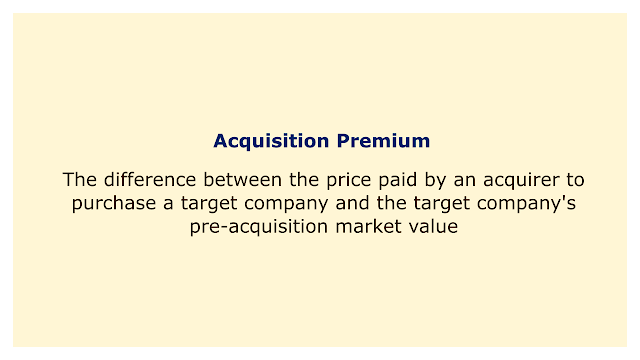 |
| Image: Moneybestpal.com |
An acquisition premium is the difference between the price paid by an acquirer to purchase a target company and the target company's pre-acquisition market value.
It stands for the additional sum that an acquirer is prepared to spend to take over the target and get access to its resources, synergies, market share, clientele, or other strategic advantages.
Acquisition premiums vary depending on several factors, such as:
As they influence the value generation or destruction from a merger or acquisition, acquisition premiums are essential for both acquirers and targets. The risk of overpaying for a target company and the potential reduction in return on investment (ROI) are two things that acquirers may experience when paying a hefty acquisition premium. Receiving a substantial purchase premium could boost the value of the targets' stock and demonstrate their market appeal.
Acquisition premiums are typically represented as a percentage of the target's pre-acquisition market value. The acquisition premium, for instance, is 20% if an acquirer pays $120 million to buy a target company with a market value of $100 million. As an alternative, acquisition premiums can also be computed as a multiple of the target's earnings before interest, taxes, depreciation, and amortization (EBITDA). The acquisition premium is 12 times EBITDA, for instance, if an acquirer spends $120 million to purchase a target company with an EBITDA of $10 million.
Acquisition premiums vary depending on several factors, such as:
- The degree of rivalry between prospective buyers. When each bidder competes to outbid the others, the acquisition premium is more likely to be higher if there are several bidders for the target firm.
- The anticipated merger or acquisition synergies. Synergies are the cost reductions or revenue increases that happen when two businesses are combined. An acquirer may be willing to pay a greater acquisition premium if it anticipates realizing considerable synergies from purchasing a target company.
- The target's and the acquirer's strategic alignment. A merger or acquisition between an acquirer and a target may have a better strategic case if their products, services, markets, or technologies are complementary. Moreover, this might support a greater acquisition premium.
- The target company's potential for growth. A target firm may command a greater acquisition premium if it has significant growth potential in its sector or market as an acquirer looks to capture its future worth.
- The target company's ability to negotiate. A target company may have more negotiating power when asking for a higher acquisition premium if it has a valuable or distinctive asset, like a patent, a well-known brand name, or a strong customer base.
As they influence the value generation or destruction from a merger or acquisition, acquisition premiums are essential for both acquirers and targets. The risk of overpaying for a target company and the potential reduction in return on investment (ROI) are two things that acquirers may experience when paying a hefty acquisition premium. Receiving a substantial purchase premium could boost the value of the targets' stock and demonstrate their market appeal.
